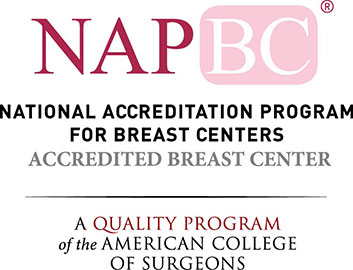Breast Health
Your Journey. Our Focus.
One in eight women will develop breast cancer in her lifetime. Early detection is key – breast cancer is highly treatable when caught early. That’s why we offer convenient access to screening mammography, close to home.
We provide comprehensive care for breast cancer and other conditions such as cysts, non-cancerous tumors and infections like mastitis. Our multidisciplinary team delivers advanced, compassionate care tailored to you – including access to clinical trials when appropriate.
Holy Cross Health is proud to be the first breast center in Montgomery and Prince George’s counties to achieve accreditation by the American College of Surgeons’ National Accreditation Program for Breast Centers – a reflection of our commitment to excellence in breast care. From screening to survivorship, we are with you every step of the way.


_______________________________________________________________________________________________________________________
Overview of Our Services
Expert Care. Advanced Technology. Compassionate Support.
As an accredited program for comprehensive breast care, we provide advanced screening, diagnostic and treatment services with compassion and skill:
- Digital mammography – a digital X-ray that shows abnormalities in and of the breast.
- 3D mammography – a series of images reconstructed into thin one-millimeter slices to create 3D images.
- Ductogram – injection of a contrast agent that views the breast ducts on a mammogram image to diagnose abnormal nipple discharge.
- Breast ultrasound – an image of the breast constructed with sound waves to determine if a lump is caused by a fluid-filled cyst or a solid mass.
- Ultrasound and stereotactic breast biopsy – using a hollow needle, removal of cells from a suspected breast tumor for examination under a microscope; stereotactic biopsy uses special equipment to guide the doctor to the abnormal growth.
- Breast cyst aspiration – a small needle aspiration to drain fluid from a breast cyst.
- Breast MRI – images of the breast using MRI to examine areas of concern further.
- MRI-guided biopsy – a procedure using computer technology to guide a needle to an abnormality seen on MRI.
Based on diagnostic findings, your treatment plan may include surgery, radiation therapy, hormone therapy, chemotherapy and/or targeted therapy. Breast cancer clinical trials may also be an option for you.
_________________________________________________________________________________________________________________________________________________________
When to Schedule a Mammogram
Early Detection Saves Lives.
The earlier breast cancer is detected, the better the chances for successful treatment. A screening mammogram can find cancer in its earliest, most treatable stage – even before symptoms appear.
Recommended Screening Guidelines for all Women:
- Age 40 and older
Annual screening mammograms and clinical breast exams are recommended even in good health. - High-risk women
Annual mammogram and breast MRI. - Ages 20 to 40
Clinical breast exams every three years by a healthcare provider. - Age 20 and older
Monthly breast self-exams, reporting any changes to your physician right away.
Healthy Lifestyle Habits that can Lower Your Risks:
- Exercise regularly.
- Maintain a healthy weight.
- Eat a healthy diet.
- Limit your intake of alcohol to no more than one drink per day.
- Avoid smoking.
_________________________________________________________________________________________________________________________________________________________
Types of Breast Cancer We Treat
Offering Hope for Healing and Healthy Comebacks
Breast cancer can begin in different areas of the breast – the ducts, lobules or in some cases, the tissue in between. No one knows the exact cause of breast cancer or why one woman develops breast cancer and another doesn’t. At Holy Cross Health, our skilled and compassionate team cares for a wide range of breast cancers, including:
- Ductal Carcinoma In Situ (DCIS)
DCIS is the most common type of noninvasive breast cancer that develops inside a milk duct.
Although it is not life-threatening, it can increase the risk of developing invasive breast cancer or recurrent DCIS. - Invasive Ductal Carcinoma (IDC)
Sometimes called infiltrating ductal carcinoma, IDC is the most common type of invasive breast cancer, with an incidence of about 80 percent of all breast cancers. It breaks through the wall of the milk duct and begins to invade the surrounding breast tissue. IDC can spread to lymph nodes and possibly other areas of the body. - Invasive Lobular Carcinoma (ILC)
ILC, sometimes called Infiltrating Lobular Carcinoma, is the second most common type of breast cancer. About 10 percent of all invasive breast cancers are ILC. It breaks through the wall of the lobule and begins to invade the surrounding breast tissue. Over time, ILC can spread to lymph nodes and possibly other areas of the body. - Inflammatory Breast Cancer (IBC)
IBC is a rare and aggressive form of breast cancer. According to the National Cancer Institute, one to five percent of all breast cancers in the United States are IBC. It usually starts with reddening and swelling of the breast rather than a distinct lump. IBC can grow and spread quickly, with symptoms worsening within days or even hours. It is critical to recognize the symptoms and seek treatment right away.
_________________________________________________________________________________________________________________________________________________________
Services We Offer
From Screening to Survivorship
At Holy Cross Health, our team of specialists, nurses, technologists and clinicians works together to deliver comprehensive, compassionate breast care. From early screening to advanced treatment and recovery, your care is personalized to your unique needs. Our services include:
- Digital Mammography
High-resolution digital X-rays to detect breast abnormalities. - 3D Mammography (Tomosynthesis)
Thin, 3D image slices for more accurate detection of early cancer signs. - Ductogram
Contrast-enhanced imaging to evaluate abnormal nipple discharge. - Breast Ultrasound
Uses sound waves to visualize abnormalities and determine if a lump is a fluid-filled cyst or solid mass. - Ultrasound-Guided and Stereotactic Breast Biopsy
Minimally invasive procedures that use imaging to guide tissue sampling for diagnosis. - Breast Cyst Aspiration
A small needle procedure to drain fluid from a benign breast cyst. - Breast MRI
Detailed imaging to further assess suspicious areas or evaluate dense breast tissue. - MRI-Guided Biopsy
Computer-assisted technology to precisely locate and biopsy abnormalities seen on MRI. - Nurse Navigation
Dedicated nurse navigators help guide your care, coordinate with specialists and support you throughout your journey.
Based on diagnostic findings, your treatment plan may include surgery, radiation therapy, hormone therapy, chemotherapy and/or targeted therapy. Breast cancer clinical trials may also be an option for you.
_________________________________________________________________________________________________________________________________________________________
Treatment Options
Your Care Plan. Our Expertise.
Holy Cross Health’s Cancer Center offers a variety of advanced treatment options for breast cancer. Your care team will create an individual care plan for your specific diagnosis. You will discuss the best treatment options with your doctor, based on factors that include:
- Stage of your breast cancer
- Size of the tumor in relation to the size of your breast
- Lab test results, including whether the breast cancer cells are hormone-dependent
- Whether you have gone through menopause
- Your personal feelings and concerns about body image
- Your general health
With access to the latest technologies and techniques, your doctor will recommend treatments that may include one or a combination of two or more options:
- Surgery
- Breast Sparing Surgery – removes the cancer and some surrounding normal tissue through a lumpectomy or partial mastectomy.
- Mastectomy – removes the entire breast or most breast tissue and may include removal of some or all lymph nodes under the arm. You may also decide to have breast reconstruction with a plastic surgeon at the time of surgery or later.
- Breast Reconstruction Surgery – uses plastic surgery techniques to restore the removed breast to near-normal shape, appearance and size.
- Microsurgical Breast Reconstruction – using your own tissue to reconstruct your breast.
- Prosthetic Breast Reconstruction – using saline or silicone implants under the skin or chest muscle.
- Radiation Therapy
Radiation beams target your cancer cells from outside your body or internally to the breast using a balloon-catheter device called MammoSite. - Chemotherapy
Drugs by IV (intravenously) or pill are given to kill cancer cells. - Targeted Therapy
Specific drugs that block the growth of breast cancer cells can be used, based on your individual diagnosis. - Hormone Therapy
This treatment is used to block certain hormones that can cause breast cancer to grow or return. - Lymphedema Therapy
This special therapy – including range-of-motion exercises, compression and drainage – addresses fluid build-up that may occur, especially if surgery involves the lymph nodes.
Treatments for breast cancer may cause side effects for some women. Sometimes, cancer-targeted therapy can also damage healthy cells and tissues. With proper precautions, we can help reduce your side effects or, in some cases, even prevent them.
_________________________________________________________________________________________________________________________________________________________
Clinical Trials
Offering Hope for You Today and Others Tomorrow
At Holy Cross Health Cancer Center, we are pleased to offer access to innovative treatment options through these clinical trials. Please ask your doctor or call 1-855-HCH-HOPE (1-855-424-4673) to see if you qualify for any of these studies.
Trial #: D3614C00001 CAPItello-290
Sponsor: AstraZeneca
Trial Sub-Type: Locally Advanced (Inoperable) or Metastatic Triple-Negative Breast Cancer (TNBC)
Title and Key Inclusion/Exclusion Criteria: A Phase III Double-blind Randomised Study Assessing the Efficacy and Safety of Capivasertib + Paclitaxel Versus Placebo + Paclitaxel as First-line Treatment for Patients with Histologically Confirmed, Locally Advanced (Inoperable) or Metastatic Triple-Negative Breast Cancer (TNBC).
Trial #: D3614C00002 CAMBriA-1
Sponsor: AstraZeneca
Trial Sub-Type: HR+/HER2- early breast cancer
Title and Key Inclusion/Exclusion Criteria: A Phase III, Open-Label, Randomised Study to Assess the Efficacy and Safety of Switching to AZD9833 (a Next Generation, Oral SERD) vs Continuing Standard Endocrine Therapy (Aromatase Inhibitor or Tamoxifen) in patients with HR+/HER2- early breast cancer and an intermediate or high risk of recurrence who have completed definitive locoregional therapy and at least 2 years of adjuvant endocrine therapy without disease recurrence (CAMBriA-1)
Trial #: NSABP B-59/ GeparDouze
Trial Sub-Type: Neoadjuvant Triple-Negative Breast Cancer
Title and Key Inclusion/Exclusion Criteria: A randomized, double-blind, Phase III clinical trial of Neoadjuvant Chemotherapy with Atezolizumab or placebo in patients with Triple-Negative Breast Cancer followed by adjuvant continuation of Atezolizumab or placebo.
Trial #: NSABP B-60 COMING SOON!
Trial Sub-Type: Clinically T1-4, N0-3, M0 prior to neoadjuvant therapy (Note: Patients presenting with T1N0 tumors will not be eligible)
Title and Key Inclusion/Exclusion Criteria: A Phase 3, Multicenter, Randomized, Open-Label, Active-Controlled Study of Trastuzumab Deruxtecan (T-DXd) Versus Trastuzumab Emtansine (T-DM1) in Subjects with High-Risk HER2-Positive Primary Breast Cancer Who Have Residual Invasive Disease in Breast or Axillary Lymph Nodes Following Neoadjuvant Therapy.

